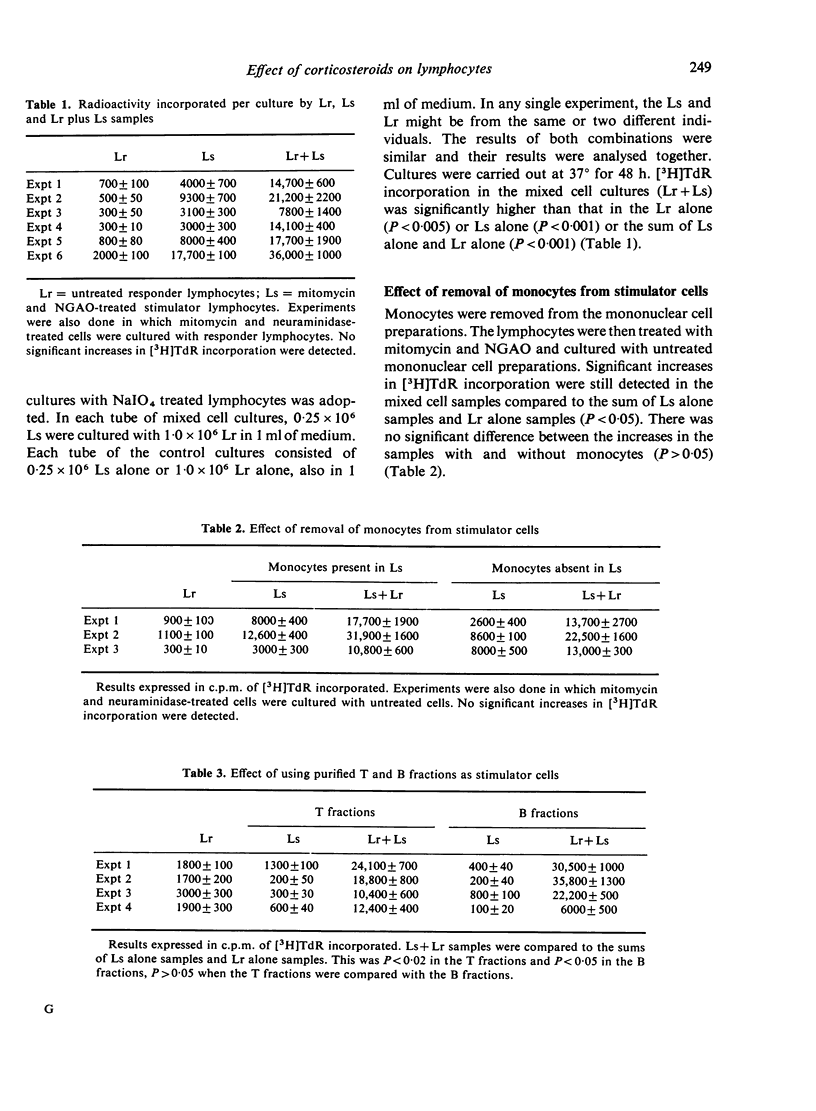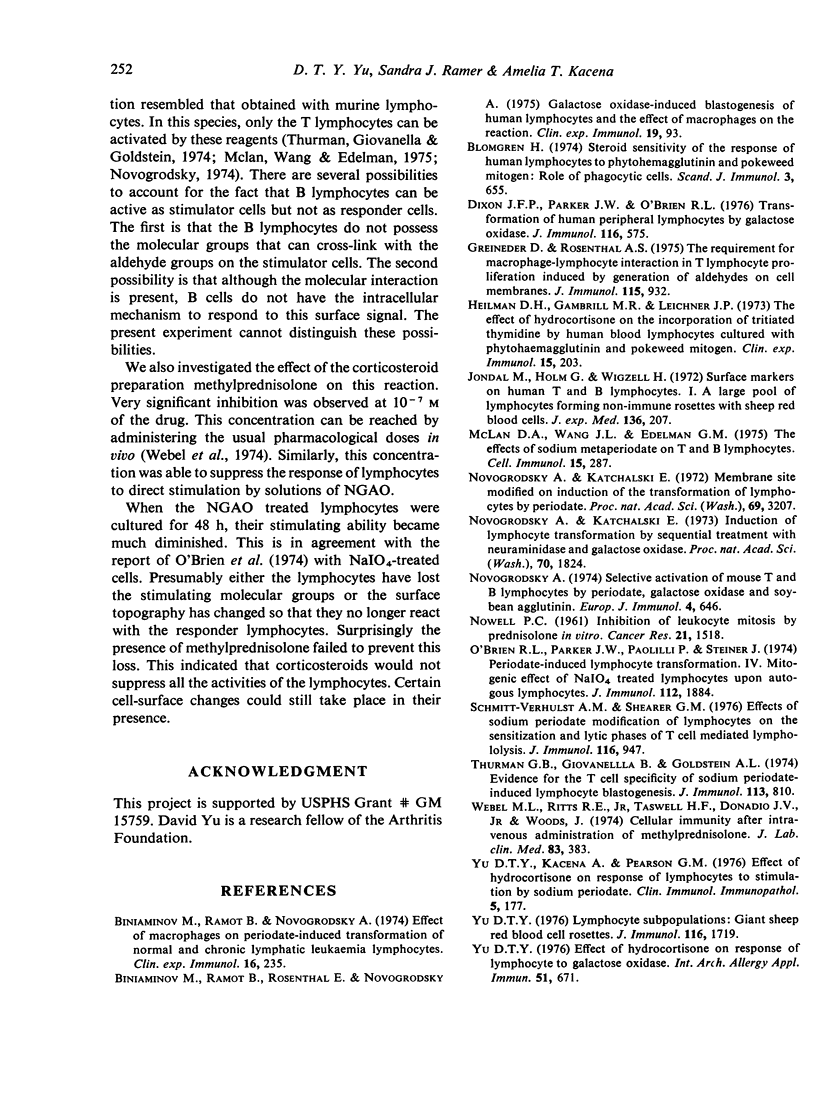Abstract
Human peripheral blood mononuclear cell preparations, after treatment by neuraminidase plus galactose oxidase, stimulated untreated lymphocytes. The increases in tritiated thymidine incorporation in the responder lymphocytes were observed after 48 h of mixed cell cultures. Monocytedepleted lymphocyte preparations were equally effective stimulator cells. Both purified T and B fractions were effective stimulator cells. On the other hand, only the T but not the B fractions could respond to the stimulation. The response of the cells to this type of stimulation was suppressed by 10(4)-10(7) M of the corticosteroid preparation methylprednisolone. When the cells treated with neuraminidase plus galactose oxidase were cultured alone for 48 h, they lost their stimulating capacity. However this loss could not be prevented by the presence in the culture of methylprednisolone. Hence the drug has selective suppressive activity on one type of lymphocyte activity but not the other.
Full text
PDF





Selected References
These references are in PubMed. This may not be the complete list of references from this article.
- Biniaminov M., Ramot B., Rosenthal E., Novogrodsky A. Galactose oxidase-induced blastogenesis of human lymphocytes and the effect of macrophages on the reaction. Clin Exp Immunol. 1975 Jan;19(1):93–98. [PMC free article] [PubMed] [Google Scholar]
- Blomgren H. Steroid sensitivity of the response of human lymphocytes to phytohemagglutinin and pokeweed mitogen: role of phagocytic cells. Scand J Immunol. 1974;3(5):655–664. doi: 10.1111/j.1365-3083.1974.tb01299.x. [DOI] [PubMed] [Google Scholar]
- Dixon J. F., Parker J. W., O'Brien R. L. Transformation of human peripheral lymphocytes by galactose oxidase. J Immunol. 1976 Mar;116(3):575–578. [PubMed] [Google Scholar]
- Greineder D. K., Rosenthal A. S. The requirement for macrophage-lymphocyte interaction in T lymphocyte proliferation induced by generation of aldehydes on cell membranes. J Immunol. 1975 Oct;115(4):932–938. [PubMed] [Google Scholar]
- Heilman D. H., Gambrill M. R., Leichner J. P. The effect of hydrocortisone on the incorporation of tritiated thymidine by human blood lymphocytes cultured with phytohaemagglutinin and pokeweed mitogen. Clin Exp Immunol. 1973 Oct;15(2):203–212. [PMC free article] [PubMed] [Google Scholar]
- Jondal M., Holm G., Wigzell H. Surface markers on human T and B lymphocytes. I. A large population of lymphocytes forming nonimmune rosettes with sheep red blood cells. J Exp Med. 1972 Aug 1;136(2):207–215. doi: 10.1084/jem.136.2.207. [DOI] [PMC free article] [PubMed] [Google Scholar]
- McClain D. A., Wang J. L., Edelman G. M. The effects of sodium metaperiodate on T and B lymphocytes. Cell Immunol. 1975 Feb;15(2):287–293. doi: 10.1016/0008-8749(75)90007-6. [DOI] [PubMed] [Google Scholar]
- NOWELL P. C. Inhibition of human leukocyte mitosis by prednisolone in vitro. Cancer Res. 1961 Dec;21:1518–1521. [PubMed] [Google Scholar]
- Novogrodsky A., Katchalski E. Induction of lymphocyte transformation by sequential treatment with neuraminidase and galactose oxidase. Proc Natl Acad Sci U S A. 1973 Jun;70(6):1824–1827. doi: 10.1073/pnas.70.6.1824. [DOI] [PMC free article] [PubMed] [Google Scholar]
- Novogrodsky A., Katchalski E. Membrane site modified on induction of the transformation of lymphocytes by periodate. Proc Natl Acad Sci U S A. 1972 Nov;69(11):3207–3210. doi: 10.1073/pnas.69.11.3207. [DOI] [PMC free article] [PubMed] [Google Scholar]
- Novogrodsky A. Selective activation of mouse T and B lymphocytes by periodate, galactose oxidase and soybean agglutinin. Eur J Immunol. 1974 Oct;4(10):646–648. doi: 10.1002/eji.1830041003. [DOI] [PubMed] [Google Scholar]
- O'Brien R. L., Parker J. W., Paolilli P., Steiner J. Periodate-induced lymphocyte transformation. IV. Mitogenic effect of NaIO4 treated lymphocytes upon autologous lymphocytes. J Immunol. 1974 May;112(5):1884–1890. [PubMed] [Google Scholar]
- Schmitt-Verhulst A., Shearer G. M. Effects of sodium periodate modification of lymphocytes on the sensitization and lytic phases of T cell-mediated lympholysis. J Immunol. 1976 Apr;116(4):947–958. [PubMed] [Google Scholar]
- Tak Yan Yu D. Effect of hydrocortisone on response of human lymphocytes to galactose oxidase stimulation. Int Arch Allergy Appl Immunol. 1976;51(6):671–680. doi: 10.1159/000231645. [DOI] [PubMed] [Google Scholar]
- Thurman G. B., Giovanella B., Goldstein A. L. Evidence for the T cell specificity of sodium periodate-induced lymphocyte blastogenesis. J Immunol. 1974 Sep;113(3):810–812. [PubMed] [Google Scholar]
- Webel M. L., Ritts R. E., Jr, Taswell H. F., Danadio J. V., Jr, Woods J. E. Cellular immunity after intravenous administration of methylprednisolone. J Lab Clin Med. 1974 Mar;83(3):383–392. [PubMed] [Google Scholar]
- Yu D. T. Human lymphocyte subpopulations: giant SRBC rosettes. J Immunol. 1976 Jun;116(6):1719–1724. [PubMed] [Google Scholar]
- Yu D. T., Kacena A., Pearson C. M. Effect of hydrocortisone on response of lymphocytes to stimulation by sodium periodate. Clin Immunol Immunopathol. 1976 Mar;5(2):177–181. doi: 10.1016/0090-1229(76)90023-4. [DOI] [PubMed] [Google Scholar]


